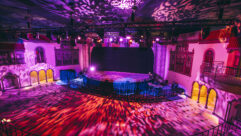
Buyer’s Guide:
Powered PA Loudspeakers
Jan 1, 2006 12:00 PM,
By Bruce Borgerson
New trends fuel the explosion.
Charts

Renkus-Heinz STLA9
A dozen years ago, powered PA loudspeakers were the rare exceptions. Today, though not exactly the rule, they certainly command a significant and steadily increasing share of the professional marketplace. No matter what your application or budget, it’s almost dead certain that you can find self-powered loudspeakers tailored for the job.
OBVIOUS ADVANTAGES
The advantages of self-powered loudspeakers have been known for decades. Efficiency and performance certainly top the list. By eliminating speaker cables and tailoring signal processing and amplifiers to the combined system response (drivers plus enclosure), self-powered systems can offer increased output and reduced distortion for each watt expended. Self-powering eliminates amplifier racks, simplifies installation, and reduces the chance of miswiring. Also, this approach allows greater system configuration flexibility because each loudspeaker is addressable as a discrete instrument. In portable systems, setup is faster because fewer components need to be connected.
So, why did self-powering take so long to take off? Until recently, the advantages were counterbalanced by a list of drawbacks nearly as long. The amplifiers were too heavy, cooling was problematic, and when loudspeakers were flown the amplifiers could be difficult to access for repairs. Also, costs were generally higher as each speaker required a complete amplifier (usually multichannel) with its own power supply and drive processing. Finally, AC power had to be supplied to each loudspeaker location.
Over the past two decades, advancing technology and mass manufacturing have whittled away at the barriers. New amplifier designs have drastically reduced weight while increasing efficiency (less cooling required) and extending reliability. Mass manufacturing of electronic components — integrated circuits in particular — has cut the cost of both amplifiers and processing. Finally, mushrooming sales worldwide have introduced an economy of scale that now makes powered models cost-competitive at every level.
Granted, you still have to find a place to plug in your AC power but, with the possible exception of extensive system retrofits in older buildings, this necessity is rarely a serious hindrance.
BREAKTHROUGH TRENDS
Looking back at the last dozen years of advancing powered loudspeaker technology, three breakthrough trends stand out.
The most recent trend receives top billing, as it promises to set the stage for the future of powered loudspeaker technology. Increasingly, we can expect loudspeaker manufacturers to offer twin lines of both conventional and unpowered versions. This modular approach lets a user upgrade a system using amplifiers and processors already in place, while allowing future additions from the sonically compatible self-powered line. Overall manufacturing costs are reduced by economy of scale, as all loudspeaker components are the same for both versions, and no separate inventories need to be maintained. For further flexibility, some higher-end versions of these power modules also offer sub-modules for system monitoring and control, and for networked digital audio inputs.
Renkus-Heinz has been a pioneer of this concept, and the company now offers six modules that can be fitted (as appropriate) into more than 35 loudspeaker models. JBL has also introduced this concept into its line array products, offering the DrivePack for two of its Vertec cabinets early in 2005. More recently, Bag End and Tannoy have jumped on the bandwagon, the latter with a module incorporating sophisticated DSP functions similar to those in the high-end Renkus-Heinz modules.
This escalating trend also takes precedence because, due to space limitations, all loudspeaker models accepting these power modules could not be listed individually. Therefore, in many cases, only the power modules are listed, with each applicable series entered under the respective category. (I predict that, should a similar database be attempted two or three years from now, it would have to be reconfigured entirely to address this snowballing trend.)
EONS AGO, AND BEFORE
The middle trend was launched in 1995, when JBL first introduced the compact EON self-powered loudspeaker. Since then, the company has sold more than a half million of the sculpted EON series units, spawning a host of imitators in the process. As a result, the compact, self-powered, molded cabinet loudspeaker — usually with onboard mic preamp and basic mixing — is now one of the fastest-growing segments of the loudspeaker market.
A year earlier, in 1994, the first notable trend point was set when Meyer Sound introduced its first self-powered sound reinforcement product, the MSL-4. This debut was significant not so much for the MSL-4 itself, but rather for the company’s early commitment to overhaul its entire line and concentrate exclusively on self-powered technology. That goal was largely achieved within five years. By carving out a steadily growing niche — the high-end touring and installation market — Meyer Sound proved that the technical and logistical problems were surmountable. This success paved the way for the others to follow, at all levels of the sound reinforcement market.
WHAT’S IN, WHAT’S OUT
The following database is designed to provide a useful guide to self-powered, front-of-house PA loudspeakers. The focus is on models that are principally designed for permanent installation or professional use in touring sound or AV production. As such, studio monitors and stage monitors are excluded, as are all-in-one, standalone portable units that are clearly not designed for use in installations or integration into larger systems. (However, many of these are included in the molded loudspeaker technology showcase article on page 46.) As a somewhat arbitrary cutoff point, loudspeakers with a total low-mid driver diameter of less than 10in. were excluded as being generally too small for FOH use. Special-order products, as well as a few highly specialized units with limited applications, were also set aside.
Straddling a fuzzy gray line are the relatively inexpensive models now flooding into the low-end contracting and MI markets. Some in this group are included here, particularly those distributed by manufacturers that also serve the professional and installation markets. Although not suited to critical applications, these models can be considered for secondary applications when you’re caught in a “value engineering” crunch. Many other low-cost models have been excluded, however, for a number of reasons, such as complete technical data is not readily available, passive crossovers are used between LF and HF sections, no mounting or flying facilities are offered, or combinations thereof.
Also excluded from the listings were the pre-engineered, integrated systems from KV2. Although highly innovative and offering many of the same advantages as amp-in-the-box systems, the KV2 concept places the amplifier and processing in a separate external module. Another tip of the hat goes to Bose for its compact Cylindrical Radiator system, a product that both benefits and suffers from occupying a category of one.
Finally, some manufacturers are introducing wireless powered loudspeakers to models in the lower end of the market. In most professional and installed sound applications, the well-known hazards of wireless systems in today’s crowded airwaves probably outweigh the benefits. Therefore, these models are not included, though similar units from the same manufacturer are listed.
THE CATEGORIES
The preceding database is organized in five categories. Listed first are the trailblazers in modular self-powered technology. Again, they receive top billing because the smaller space allotted belies their relative importance. The modules are noted in all subsequent categories where applicable models would fit, and prospective buyers are advised to further investigate the referenced series for more in-depth comparisons.
Line arrays are next, as this technology also continues to gain increasing favor. All sizes are listed together, including subwoofers designed for integration into the arrays. Also included are the innovative DSP-controlled beam steering arrays, a sophisticated new technology that could not be implemented without discrete self-powering of individual drivers.
The Main Loudspeakers section comprises models with a combined low-mid driver diameter of 15in. or larger. This is a somewhat arbitrary classification, but at least it is objective. Those with combined low-mid driver diameters between 10in. and 15in. are gathered in the Compact/Fill category, though a few are used as the main house speakers when combined in clusters. Mid-bass and subwoofer units are gathered in the final listing.
UNFOLDING THE DATA
Since a powered loudspeaker is really three components — loudspeaker, drive processor, and amplifier — in one box, any attempt to list comprehensive specifications for each would quickly result in a volume the size of a small telephone directory. Certainly, that is not the purpose of this guide. The intention here is to list those specifications that will be most useful in selecting or grouping various models for further, in-depth comparison. Limiting the data allows the prospective buyer to quickly scan through the listings to determine which models meet broad criteria for power, bandwidth, weight, cost, or input/output facilities. Website addresses are provided at the end of this article to facilitate further investigations.
All data is taken from specifications published by the manufacturer, with the exception of some prices which were supplied by authorized dealers. Some information, such as driver complement and weight, is fairly straightforward. Most HF drivers are listed with exit diameters; those using diaphragm diameter are noted when that measurement is known.
Measured specifications, however, are subject to varying conditional criteria that (even when available) cannot be given here in detail. Some figures can be subject to interpretation. Therefore, measured specifications listed here should be used as rough guides only, with further scrutiny advised before final decisions are made.
A similar caveat applies to pricing: Some net costs may hold at the given cost while others will have “street prices” with significant discounts. Note that loudspeakers in higher price categories usually offer critical-use options (such as remote monitoring) not available on lower-priced units. Also, premium-priced units normally come with a higher level of technical support, availability of high-resolution measurement data for use in modeling programs, and more options for comprehensive system integration.
Finally, although this guide is likely among the most comprehensive surveys of powered loudspeakers yet published, it cannot claim to be definitive. New models are being introduced almost weekly, and in a teeming global marketplace, some makers may have been overlooked. It’s a burgeoning technology. Today’s powered loudspeaker buyer enjoys a dizzying multitude of choices, and even more are on the way.
One final note on the specifications. Amplifier power ratings, and acoustic output and frequency response, are the highest or best given when more than one figure is stated. However, exact test conditions will vary, and figures from different manufacturers may not be comparable.
For More Information
American Audio
www.americanaudio.us
ATC
www.transaudiogroup.com/atc.shtml
Bag End
www.bagend.com
Behringer
www.behringer.com
Crest Audio
www.crestaudio.com
dB Technologies
www.dbtechnologies.com
Duran Audio
www.duran-audio.com
EAW
www.eaw.com
Electro-Voice
www.electro-voice.com
FBT
www.fbt.it
Mackie
www.mackie.com
Meyer Sound
www.meyersound.com
Peavey/Architectural Acoustics
aa.peavey.com
Phonic America
www.phonic.com
Renkus-Heinz
www.renkus-heinz.com
Samson
www.samsontech.com
SoundTech
www.soundtech.com
Tannoy
www.tannoy.com
Turbosound
www.turbosound.com
Yamaha
www.yamaha.com
Yorkville
www.yorkville.com
Bruce Borgersonis a freelance writer, marketing consultant, and proprietor of Wavelength Communications in Ashland, Ore.










